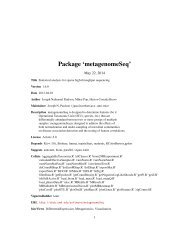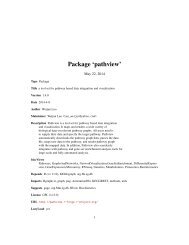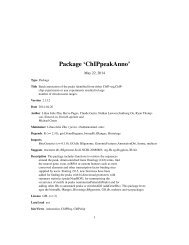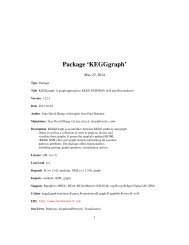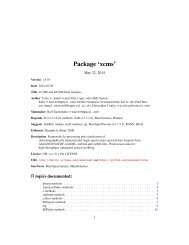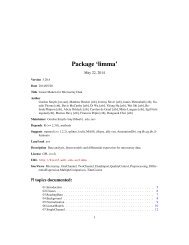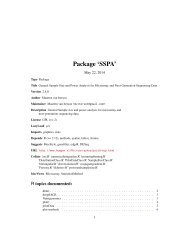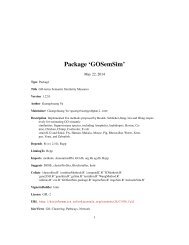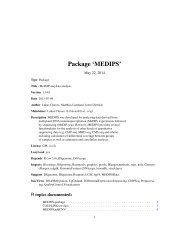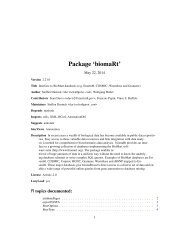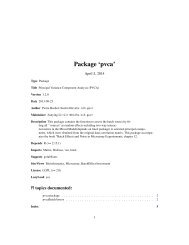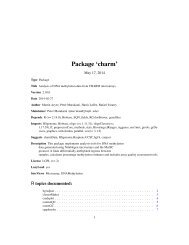Package 'virtualArray' - Bioconductor
Package 'virtualArray' - Bioconductor
Package 'virtualArray' - Bioconductor
Create successful ePaper yourself
Turn your PDF publications into a flip-book with our unique Google optimized e-Paper software.
<strong>Package</strong> ‘virtualArray’<br />
October 20, 2013<br />
Type <strong>Package</strong><br />
Encoding latin1<br />
Title Build virtual array from different microarray platforms<br />
Version 1.6.0<br />
Date 2012-12-19<br />
Author Andreas Heider<br />
Maintainer Andreas Heider <br />
Description This package permits the user to combine raw data of<br />
different microarray platforms into one virtual array. It<br />
consists of several functions that act subsequently in a<br />
semi-automatic way. Doing as much of the data combination and<br />
letting the user concentrate on analysing the resulting virtual array.<br />
Depends R (>= 2.15.0), BiocGenerics, methods, plyr, preprocessCore<br />
Imports affy, affyPLM, AnnotationDbi, Biobase, gcrma, GEOquery,graphics, methods, reshape2,<br />
stats, utils, tseries, outliers<br />
Suggests affydata, plier, limma, lumi, org.Hs.eg.db<br />
Enhances multicore,BiocParallel<br />
License GPL-3<br />
biocViews<br />
Microarray, OneChannel, DataImport, Preprocessing,Bioinformatics, MultipleComparisons<br />
LazyLoad yes<br />
LazyData yes<br />
1
2 virtualArray-package<br />
R topics documented:<br />
virtualArray-package . . . . . . . . . . . . . . . . . . . . . . . . . . . . . . . . . . . . 2<br />
GPLs . . . . . . . . . . . . . . . . . . . . . . . . . . . . . . . . . . . . . . . . . . . . 4<br />
normalize.ExpressionSet.gq . . . . . . . . . . . . . . . . . . . . . . . . . . . . . . . . 5<br />
normalize.ExpressionSet.mc . . . . . . . . . . . . . . . . . . . . . . . . . . . . . . . . 6<br />
normalize.ExpressionSet.mrs . . . . . . . . . . . . . . . . . . . . . . . . . . . . . . . . 7<br />
normalize.ExpressionSet.nordi . . . . . . . . . . . . . . . . . . . . . . . . . . . . . . . 8<br />
normalize.ExpressionSet.qd . . . . . . . . . . . . . . . . . . . . . . . . . . . . . . . . 9<br />
sample_info_imported . . . . . . . . . . . . . . . . . . . . . . . . . . . . . . . . . . . 10<br />
virtualArrayBuildExprs . . . . . . . . . . . . . . . . . . . . . . . . . . . . . . . . . . . 11<br />
virtualArrayBuildfData . . . . . . . . . . . . . . . . . . . . . . . . . . . . . . . . . . . 12<br />
virtualArrayBuildSampleInfo . . . . . . . . . . . . . . . . . . . . . . . . . . . . . . . . 13<br />
virtualArrayComBat . . . . . . . . . . . . . . . . . . . . . . . . . . . . . . . . . . . . 14<br />
virtualArrayCompile . . . . . . . . . . . . . . . . . . . . . . . . . . . . . . . . . . . . 15<br />
virtualArrayDirs . . . . . . . . . . . . . . . . . . . . . . . . . . . . . . . . . . . . . . . 16<br />
virtualArrayExpressionSets . . . . . . . . . . . . . . . . . . . . . . . . . . . . . . . . . 17<br />
virtualArrayHclust . . . . . . . . . . . . . . . . . . . . . . . . . . . . . . . . . . . . . 19<br />
virtualArrayLoadRaw . . . . . . . . . . . . . . . . . . . . . . . . . . . . . . . . . . . . 20<br />
virtualArrayMergeRecurse . . . . . . . . . . . . . . . . . . . . . . . . . . . . . . . . . 21<br />
Index 23<br />
virtualArray-package<br />
Combine raw data of several ExpressionSets into a "virtual array".<br />
Description<br />
Details<br />
Using this package one can create a new ExpressionSet object, that holds both phenoData and<br />
expression values of different microarray platforms.<br />
<strong>Package</strong>: virtualArray<br />
Type: <strong>Package</strong><br />
Version: 1.3.1<br />
Date: 2012-12-19<br />
License: GPL V3<br />
LazyLoad: yes<br />
Current tools for the analysis of microarray data only allow the comparison of datasets generated on<br />
the same platform and chip generation, and restrict meta-analysis studies to the evaluation of study<br />
results from different groups, rather than the direct comparison of the available raw datasets. With<br />
the help of the virtualArray package it becomes easy to combine raw expression data of different<br />
microarray platforms into one "virtual array". Thus, the user may compare his own data to other<br />
datasets including public sources, regardless of the platform and chip generation used, or perform
virtualArray-package 3<br />
meta-analysis directly based on available raw datasets. The package generates a combined virtual<br />
array as a "ExpressionSet" object from different datasets by matching raw data entries based on<br />
probe, transcript, gene or protein identifiers. Redundancies, gaps, and batch effects are removed<br />
before proceeding with data analysis.<br />
virtualArray consists of several subsequent functions, requiring minimal user input. Briefly, (1)<br />
raw data are loaded into R, (2) probe sets for each platform are annotated, (3) genes, proteins<br />
or transcripts common to all platforms are matched, including checks for redundancy or missing<br />
values, data are (4) compiled into a new "virtual array", (5) normalized and (6) subjected to batch<br />
effect removal using empirical Bayes methods [1], or other batch effect removal methods. Six of<br />
which have been implemented into this package. The generated "virtual array" can than be directly<br />
analyzed in R/Bioconducor or exported for use in other suitable software (e.g. MeV).<br />
There are essentially four modes of operation:<br />
Firstly, the "virtualArrayCompile" function can integrate the major (but not all) human microarray<br />
platforms in a default mode requiring only minimal user input.<br />
The second way is built around the "virtualArray.ExpressionSet" function. This approach allows<br />
to integrate any kind of raw expression data that can be loaded into an ExpressionSet object in<br />
R/BioC. The downside of this mode is that the user will have to deal with details such as log2-<br />
transformations, 16 bit - 20 bit transformations, assignment of correct annotations, etc.<br />
Finally, each of these two approaches can be used in a supervised or non-supervised mode. The<br />
non-supervised mode uses empirical Bayes methods (implemented through "ComBat.R", [1]) to<br />
adjust for batch effects between the single datasets. In the supervised mode the user assigns additional<br />
covariates next to the batch assignment. This means e.g. "treated" and "untreated", or<br />
"non-differentiated" and "differentiated". Note that this information has to be valid, as it impacts<br />
the results you will get.<br />
Last but not least it is possible to use the package to integrate data without batch effect removal.<br />
This way you can use other methods of batch effect removal than the empirical Bayes methods<br />
approach.<br />
The combined data is presented as a regular <strong>Bioconductor</strong> "ExpressionSet" object, which permits<br />
using all of R/<strong>Bioconductor</strong>’s power on the dataset as a whole.<br />
To load the package type:<br />
> library(virtualArray)<br />
Author(s)<br />
See Also<br />
Andreas Heider<br />
Maintainer: Andreas Heider <br />
virtualArray.ExpressionSet, virtualArrayCompile<br />
Examples<br />
## Please see the vignette for a comprehensive example
4 GPLs<br />
GPLs<br />
Provides precompiled mappings of NCBI GEO platform IDs (GPLs)<br />
to <strong>Bioconductor</strong> annotation packages.<br />
Description<br />
This data object can be used to translate GPL accession IDs like "GPL570" to a <strong>Bioconductor</strong><br />
annotation package like "hgu133plus2".<br />
Usage<br />
GPLs<br />
Details<br />
The "virtualArray" package provides tools to merge raw data from multiple microarray platforms.<br />
The source of this data might be an entry from the NCBI GEO web service using e.g. "get-<br />
GEO" from the "GEOquery" package. The annotation slot of the retreived ExpressionSets is<br />
filled with a GPL entry like "GPL570" which corresponds to the <strong>Bioconductor</strong> annotation package<br />
"hgu133plus2". The "GPLs" list can be used to map between these IDs and replace the annotation<br />
slot. A reverse map can be achieved using "revmap" from the annotate package.<br />
Value<br />
A list of <strong>Bioconductor</strong> annotation packages (redundant) named by their corresponding NCBI GEO<br />
GPL.<br />
Author(s)<br />
Andreas Heider (2013)<br />
See Also<br />
virtualArray-package, virtualArray.ExpressionSet, virtualArrayCompile<br />
Examples<br />
GPLs["GPL570"]
normalize.ExpressionSet.gq 5<br />
normalize.ExpressionSet.gq<br />
gene quantiles normalization<br />
Description<br />
Performs gene quantile normalization for cross-platform adjustments of microarray data. It is a<br />
modification of the median rank scores normalization.<br />
Usage<br />
normalize.ExpressionSet.gq(ExpressionSet = NULL, Batch = NULL, ...)<br />
Arguments<br />
ExpressionSet<br />
Batch<br />
An ExpressionSet object; if it contains a "Batch" column in its pData slot, this<br />
information can be used instead of the "Batch" parameter.<br />
A character or numeric vector containing batch contribution of the samples. The<br />
order of the items should be the same as the samples (column) in the supplied<br />
ExpressionSet. Defining this parameter overrides the information of the pData<br />
slot.<br />
... Can be used to pass on parameters to underlying functions.<br />
Details<br />
Please see the references for details.<br />
Value<br />
An ExpressionSet object with adjusted expression matrix.<br />
Author(s)<br />
Andreas Heider<br />
References<br />
Xia XQ, McClelland M, Porwollik S, Song W, Cong X, Wang Y: WebArrayDB: cross-platform<br />
microarray data analysis and public data repository. Bioinformatics 2009, 25:2425-2429.<br />
See Also<br />
virtualArrayExpressionSets
6 normalize.ExpressionSet.mc<br />
Examples<br />
# library(affydata)<br />
# data(Dilution)<br />
# Dilution
normalize.ExpressionSet.mrs 7<br />
See Also<br />
virtualArrayExpressionSets<br />
Examples<br />
# library(affydata)<br />
# data(Dilution)<br />
# Dilution
8 normalize.ExpressionSet.nordi<br />
References<br />
Warnat P, Eils R, Brors B: Cross-platform analysis of cancer microarray data improves gene expression<br />
based classification of phenotypes. BMC bioinformatics 2005, 6:265.<br />
See Also<br />
virtualArrayExpressionSets<br />
Examples<br />
# library(affydata)<br />
# data(Dilution)<br />
# Dilution
normalize.ExpressionSet.qd 9<br />
References<br />
"GenMiner: Mining informative association rules from genomic data." Ricardo Martinez, Claude<br />
Pasquier and Nicolas Pasquier, Proceedings of the IEEE BIBM international conference on Bioinformatics<br />
and Biomedecine, pages 15-22, IEEE Computer Society, 2007.<br />
Martinez R, Pasquier N, Pasquier C: GenMiner: mining non-redundant association rules from integrated<br />
gene expression data and annotations. Bioinformatics 2008, 24:2643-2644.<br />
See Also<br />
virtualArrayExpressionSets<br />
Examples<br />
# library(affydata)<br />
# data(Dilution)<br />
# Dilution
10 sample_info_imported<br />
References<br />
Warnat P, Eils R, Brors B: Cross-platform analysis of cancer microarray data improves gene expression<br />
based classification of phenotypes. BMC bioinformatics 2005, 6:265.<br />
See Also<br />
virtualArrayExpressionSets<br />
Examples<br />
# library(affydata)<br />
# data(Dilution)<br />
# Dilution
virtualArrayBuildExprs 11<br />
virtualArrayBuildExprs<br />
Format ExpressionSets as data.frames with identifiers in first column<br />
Description<br />
This function takes ExpressionSets as input and formats the expression matrix into a data.frame<br />
whose identifiers are put into the first column<br />
Usage<br />
virtualArrayBuildExprs(x)<br />
Arguments<br />
x<br />
An ExpressionSet<br />
Details<br />
This function is normally only called by "virtualArray.ExpressionSet". It can be used, however,<br />
to extract the "exprs" slot of an ExpressionSet as a data.frame. At the same time the identifiers<br />
(rownames) are saved in column "1" of the data.frame.<br />
Value<br />
The value returned is a data.frame which is based on the expression matrix of the input Expression-<br />
Set.<br />
Author(s)<br />
Andreas Heider<br />
See Also<br />
virtualArray-package, virtualArray.ExpressionSet, virtualArrayCompile<br />
Examples<br />
## first we need to load dummy data<br />
library(affydata)<br />
data(Dilution)<br />
## we apply RMA to get an ExpressionSet<br />
Dilution
12 virtualArrayBuildfData<br />
virtualArrayBuildfData<br />
Collapses expression values according to given identifiers<br />
Description<br />
Expression values are collapsed according to given identifiers, e.g. gene symbols. In the same run,<br />
a data.frame with 2 columns to fill the "fData" slot of the ExpressionSet is build. The data is pulled<br />
from the <strong>Bioconductor</strong> annotation package defined in the "annotation" slot of the ExpressionSet.<br />
Usage<br />
virtualArrayBuildfData(x, identifier = "SYMBOL", collapse_fun = median)<br />
Arguments<br />
x<br />
identifier<br />
collapse_fun<br />
Name of an ExpressionSet as a character vector<br />
Wich identifier to pull from the annotation (default="SYMBOL"). Theoretically<br />
it can be anything that is supported by the annotation package. Practically it is<br />
limited to identifiers giving a 1 to 1 mapping, such as ENTREZID, SYMBOL,<br />
GENENAME, UNIPROT, UNIGENE, etc. Identifiers giving 1 to 1+ mappings<br />
will be supported in future versions of the package.<br />
Which function to use to treat multiple lines targetting the same gene (default=median)<br />
Details<br />
This function is normally only called from "virtualArray.ExpressionSet". You can use it, however,<br />
to collapse expression values referring to the same identifier together with their corresponding annotation<br />
in the "exprs" and "fData" slots by means of a user specified function (default is "median").<br />
Note, that it is critical to define the correct <strong>Bioconductor</strong> annotation package in the "annotation" slot<br />
of the ExpressionSet and that the name of the ExpressionSet must be supplied as a character vector,<br />
due to the implementation in "virtualArray.ExpressionSet".<br />
Value<br />
The value returned is an ExpressionSet whose "fData" slot has been filled with the selected identifiers.<br />
The rows in the expression matrix ("exprs" slot) have been collapsed to the selected identifiers.<br />
Therefore the size of the expression matrix has decreased during the process.<br />
Author(s)<br />
Andreas Heider<br />
See Also<br />
virtualArray-package, virtualArray.ExpressionSet, virtualArrayCompile
virtualArrayBuildSampleInfo 13<br />
Examples<br />
## first we need to load dummy data<br />
library(affydata)<br />
data(Dilution)<br />
## we apply RMA to get an ExpressionSet<br />
Dilution
14 virtualArrayComBat<br />
Examples<br />
## first we need to load dummy data<br />
library(affydata)<br />
data(Dilution)<br />
data(sample.ExpressionSet)<br />
## we apply RMA to get an ExpressionSet<br />
Dilution
virtualArrayCompile 15<br />
Value<br />
Returns a matrix holding adjusted expression values.<br />
Note<br />
Original code by Johnson, WE, Rabinovic, A, and Li, C, made available in this package by Andreas<br />
Heider<br />
Author(s)<br />
Original author: Johnson, WE, Rabinovic, A, and Li, C (2007)<br />
Modified by: Andreas Heider (2011)<br />
References<br />
Johnson, WE, Rabinovic, A, and Li, C (2007). Adjusting batch effects in microarray expression<br />
data using Empirical Bayes methods. Biostatistics 8(1):118-127.<br />
See Also<br />
virtualArray-package, virtualArray.ExpressionSet, virtualArrayCompile<br />
Examples<br />
## EMPTY<br />
virtualArrayCompile<br />
Compiles a single virtual array holding user provided microarray data<br />
from multiple platforms.<br />
Description<br />
The function takes ExpressionSets of rawdata provided by the "virtualArrayLoadRaw" function together<br />
with annotation data.frames provided by the function "virtualArray.load.annot" and matches<br />
the rawdata on the basis of the given identifier. Currently only "Gene.Symbol" is supported by<br />
"virtualArrayCompile" but this will be extendend in future versions. Meanwhile you can use "virtualArray.ExpressionSet"<br />
to use other identifiers.<br />
Usage<br />
virtualArrayCompile(root_dir = getwd(), identifier = "Gene.Symbol", covars= 3, virtualArray = virtualAr
16 virtualArrayDirs<br />
Arguments<br />
root_dir<br />
identifier<br />
covars<br />
virtualArray<br />
The top level directory holding the rawdata and the "sample_info.txt" file.<br />
The annotation identifier based on which the comparison between the different<br />
platforms is made.<br />
Numer of columns to read from "sample_info" data.frame or ".txt". Defaults to<br />
3, which denotes only to use the sample/array naming and the "Batch" column.<br />
A 4 expects the "Covariate.1" column to be filled with meaningful information<br />
regarding grouping of samples. When the value is the character vector "all" even<br />
more columns can be used.<br />
A list which holds the intermediate output of the "virtArray" package. It contains<br />
both raw data as well as annotation data.frames. It defaults to "virtualArray" but<br />
can be any other name.<br />
Value<br />
An ExpressionSet is created, holding data of all supplied microarray platforms.<br />
Author(s)<br />
Andreas Heider (2011)<br />
See Also<br />
virtualArray-package, virtualArray.ExpressionSet, virtualArrayCompile<br />
Examples<br />
# This is example is commented out, because it would slow down building the package!<br />
# virtualArrayDirs()<br />
# getGEOSuppFiles(baseDir="rawdata/Affymetrix/U133Plus2/",makeDirectory=F,GEO="GSM589512")<br />
# gunzip(filename="rawdata/Affymetrix/U133Plus2/GSM589512.CEL.gz",remove=T)<br />
# getGEOSuppFiles(baseDir="rawdata/Affymetrix/U133A/",makeDirectory=F,GEO="GSM589506")<br />
# getGEOSuppFiles(baseDir="rawdata/Affymetrix/U133A/",makeDirectory=F,GEO="GSM589509")<br />
# gunzip(filename="rawdata/Affymetrix/U133A/GSM589506.CEL.gz",remove=T)<br />
# virtualArray
virtualArrayExpressionSets 17<br />
Usage<br />
virtualArrayDirs(root_dir = getwd())<br />
Arguments<br />
root_dir<br />
If declared, this variable sets the top level directory where the whole tree will be<br />
placed.<br />
Details<br />
Value<br />
The directory tree consists of a top level folder called "rawdata". Inside this folder there are directories<br />
for "Affymetrix", "Agilent" and "Illumina" respectively. Each folder holds sub-folders for the<br />
specific chips of the respective manufacturer. The user has to supply copies of the raw data into the<br />
appropriate directories for the package to work as expected.<br />
This function returns no value. It just creates a directory tree.<br />
Author(s)<br />
See Also<br />
Andreas Heider (2011)<br />
virtualArray-package, virtualArray.ExpressionSet, virtualArrayCompile<br />
Examples<br />
## we use the function in the current working directory<br />
## please note that this will write to your hard drive<br />
virtualArrayDirs()<br />
## now we can see what happened<br />
dir(recursive=TRUE)<br />
virtualArrayExpressionSets<br />
Combine different ExpressionSets into one<br />
Description<br />
This function selects all ExpressionSets in the current environment and builds a new single ExpressionSet<br />
of the raw data included in the input. This is done by annotating the expression values with<br />
the selected identifiers, that are pulled from <strong>Bioconductor</strong> annotation packages. Then lines targetting<br />
the same gene are collapsed by the specified function. In the next step compatible rows of the<br />
expression matrices are merged. As a final step batch effects resulting from different platforms or<br />
labs can be removed in a supervised or non-supervised mode.
18 virtualArrayExpressionSets<br />
Usage<br />
virtualArrayExpressionSets(all_expression_sets=FALSE, identifier = "SYMBOL", covars = "Batch", collaps<br />
Arguments<br />
Details<br />
all_expression_sets<br />
Logical or a character vector. If "FALSE", "virtualArray" tries to catch all ExpressionSets<br />
in the current environment. If set to a character vector holding<br />
names of ExpressionSets, these are used instead of all available ones.<br />
identifier<br />
covars<br />
annotation identifier by which the expression values are combined<br />
Character vector of length "1" or longer. Used to define non-supervised (length<br />
= "1") or supervised (length > "1") mode. THe default is "Batch". See details<br />
for more info.<br />
collapse_fun The function to be used to collapse expression values targetting the same gene/identifier.<br />
Defaults to "median".<br />
removeBatcheffect<br />
Logical or character vector. "FALSE" will lead to just a combined Expression-<br />
Set, you will then have to use other functions to remove the batch effects. You<br />
can set it to "EB", "GQ", "MRS", QD" ,"NORDI" or "MC" to use empirical<br />
Bayes methods, gene quantiles, median rank scores, quantile discretization ,normal<br />
discretization or mean centering to remove batch effects, respectively.<br />
sampleinfo<br />
parallel<br />
This parameter selects in which way the information of the relationships between<br />
batches and samples/datasets will be supplied. The default (FALSE) uses<br />
a sample_info data.frame that is generated on the fly from the pData slots of<br />
the supplied ExpressionSets with an additional "Batch" column. If you run in<br />
non-interactive mode, you can specify a data.frame to be used as the input "sample_info".<br />
Another option is to hand over a file name so the preconfigured text<br />
file can be fed into the procedure. Note that a text file "sample_info.txt" can be<br />
created on the fly, so you can set it up manually in this case. You can select this<br />
option using "create".<br />
A character string or a logical to select which package to use for parallel processing.<br />
Defaults to "BiocParallel", but can be "multicore", "none" or FALSE as<br />
well.<br />
... Can be used to pass on parameters to underlying functions.<br />
The "covars" argument determines the mode of batch removal. It refers to the columns in the<br />
sample_info data.frame which contains information about all ExpressionSets, their samples and<br />
relations thereof. The default value "Batch" will use only the different ExpressionSets for batch<br />
effect removal, this is referred to as the non-supervised mode. The supervised mode is to be accessed<br />
by using a character vector with a length > 1 e.g. c("Batch","celltype"). In this case a column<br />
"celltype" must be common to all pData slots of all datasets prior to invoking the package. The<br />
default name of the batch column ("Batch") can even be replaced to match another column. The<br />
sample_info data.frame is generated on the fly from the pData slots of the supplied ExpressionSets,<br />
during this procedure a "Batch" column is generated. All columns are preserved and common ones<br />
joined. These can be used as additional covariates during batch effect removal. In this case the
virtualArrayHclust 19<br />
sample_info data.frame has to be modified manually to contain more information on the batches in<br />
additional columns. Please note, that during computation you will be notified that "sample_info.txt"<br />
has been written to your current working directory for you to modify and save it. If you do so,<br />
please select "y" to use the additional columns. Also note that you can not provide a covariate that<br />
is distributed only in one batch, this way the procedure will fail.<br />
Value<br />
A new ExpressionSet is returned that combines all ExpressionSets from the current environment.<br />
Author(s)<br />
Andreas Heider (2011)<br />
See Also<br />
virtualArray-package, virtualArray.ExpressionSet, virtualArrayCompile, normalize.ExpressionSet.nordi,<br />
normalize.ExpressionSet.mrs, normalize.ExpressionSet.qd, normalize.ExpressionSet.gq<br />
Examples<br />
# Due to the flexibility of this function and the time<br />
# it takes to get meaningful results, please see the<br />
# vignette for a comprehensive example, governing<br />
# several modes of usage. Thanks.<br />
virtualArrayHclust<br />
Plot a hclust object with colored labels<br />
Description<br />
This function takes a hclust object and a vector of colors as its input and plots the hclust object with<br />
colored labels.<br />
Usage<br />
virtualArrayHclust(hclust, lab = hclust$labels, lab.col = rep(1, length(hclust$labels)), hang = 0.1, ..<br />
Arguments<br />
hclust a hclust object<br />
lab<br />
labels to use<br />
lab.col colors to use for each label<br />
hang<br />
see "hclust"<br />
... see "hclust"
20 virtualArrayLoadRaw<br />
Details<br />
This function is normally only called by "virtualArray.ExpressionSet".<br />
Value<br />
A modified hclust object is returned.<br />
Note<br />
The function was written by Eva Chan and incorporated into this package by Andreas Heider<br />
Author(s)<br />
Original author: Eva Chan<br />
Modified by: Andreas Heider (2011)<br />
See Also<br />
virtualArray-package, virtualArray.ExpressionSet, virtualArrayCompile<br />
Examples<br />
# we use the USArrests dataset<br />
new.arrests
virtualArrayMergeRecurse 21<br />
Usage<br />
virtualArrayLoadRaw(root_dir = getwd(), affy_sum = "rma")<br />
Arguments<br />
root_dir<br />
affy_sum<br />
The top level directory holding the rawdata and the "sample_info.txt" file.<br />
Select the summerization method to use for Affymetrix chips; defaults to "RMA".<br />
Details<br />
Value<br />
The function first reads in the virtualArray directory including raw data files. Based on this a<br />
"sample_info" data.frame is created holding information about chip type and the corresponding<br />
file name. Then "sample_info" is checked for the presence of certain microarray platforms. If<br />
present, the function loads raw data of all platforms. The "sample_info" data.frame is exported to<br />
"sample_info.txt". It is up to the user to change the values of the "Covariate 1" column to something<br />
meaningful, thus providing the additional information for the batch effect removal in the final step<br />
of the process.<br />
This function does not return a value, but creates objects in the current environment holding raw<br />
data of every provided chip type. The objects are named "rawdata_*". Where "*" is the chip type.<br />
Author(s)<br />
See Also<br />
Andreas heider (2011)<br />
virtualArray-package, virtualArray.ExpressionSet, virtualArrayCompile<br />
Examples<br />
## EMPTY<br />
virtualArrayMergeRecurse<br />
Merge a list of data.frames by common rows<br />
Description<br />
Usage<br />
A list of data.frames is merged together by rows common to all data.frames. The column by which<br />
the merging is performed can be selected with "by".<br />
virtualArrayMergeRecurse(dfs, by, ...)
22 virtualArrayMergeRecurse<br />
Arguments<br />
dfs<br />
by<br />
Details<br />
Value<br />
A list of data.frames<br />
Select the columns to be used for the comparison<br />
... Parameters passed on to the "merge" function.<br />
The function was adopted from the "reshape" package and modified to be suitable to handle problems<br />
arising when combining data from different microarray platforms in the "virtualArray" package.<br />
This function is normally only called by "virtualArray.ExpressionSet". It can be used, however,<br />
to merge several data.frames by common rows, whereas rows that do not match between the<br />
data.frames are discarded.<br />
A data.frame consisting of the matching parts of the input data.frames.<br />
Author(s)<br />
See Also<br />
Andreas heider (2011)<br />
virtualArray-package, virtualArray.ExpressionSet, virtualArrayCompile<br />
Examples<br />
## we set up 2 example data.frames<br />
authors
Index<br />
∗Topic ExpressionSet<br />
virtualArrayBuildfData, 12<br />
∗Topic GEO<br />
GPLs, 4<br />
∗Topic GPL<br />
GPLs, 4<br />
∗Topic array<br />
virtualArrayDirs, 16<br />
∗Topic batch effect removal<br />
normalize.ExpressionSet.gq, 5<br />
normalize.ExpressionSet.mc, 6<br />
normalize.ExpressionSet.mrs, 7<br />
normalize.ExpressionSet.nordi, 8<br />
normalize.ExpressionSet.qd, 9<br />
∗Topic batch effects<br />
virtualArrayComBat, 14<br />
∗Topic batch<br />
virtualArrayComBat, 14<br />
∗Topic combine<br />
GPLs, 4<br />
sample_info_imported, 10<br />
virtualArrayBuildExprs, 11<br />
virtualArrayBuildfData, 12<br />
virtualArrayBuildSampleInfo, 13<br />
virtualArrayDirs, 16<br />
virtualArrayExpressionSets, 17<br />
virtualArrayHclust, 19<br />
virtualArrayLoadRaw, 20<br />
virtualArrayMergeRecurse, 21<br />
∗Topic compare<br />
virtualArrayCompile, 15<br />
∗Topic cross-platform<br />
normalize.ExpressionSet.gq, 5<br />
normalize.ExpressionSet.mc, 6<br />
normalize.ExpressionSet.mrs, 7<br />
normalize.ExpressionSet.nordi, 8<br />
normalize.ExpressionSet.qd, 9<br />
∗Topic mapping<br />
GPLs, 4<br />
∗Topic merge<br />
virtualArrayDirs, 16<br />
∗Topic normalization<br />
normalize.ExpressionSet.gq, 5<br />
normalize.ExpressionSet.mc, 6<br />
normalize.ExpressionSet.mrs, 7<br />
normalize.ExpressionSet.nordi, 8<br />
normalize.ExpressionSet.qd, 9<br />
∗Topic package<br />
virtualArray-package, 2<br />
∗Topic sample_info<br />
sample_info_imported, 10<br />
∗Topic sampleinfo<br />
sample_info_imported, 10<br />
∗Topic virtualArray<br />
GPLs, 4<br />
normalize.ExpressionSet.gq, 5<br />
normalize.ExpressionSet.mc, 6<br />
normalize.ExpressionSet.mrs, 7<br />
normalize.ExpressionSet.nordi, 8<br />
normalize.ExpressionSet.qd, 9<br />
sample_info_imported, 10<br />
virtualArrayBuildExprs, 11<br />
virtualArrayBuildfData, 12<br />
virtualArrayBuildSampleInfo, 13<br />
virtualArrayExpressionSets, 17<br />
virtualArrayHclust, 19<br />
virtualArrayMergeRecurse, 21<br />
∗Topic virtual<br />
GPLs, 4<br />
sample_info_imported, 10<br />
virtualArrayBuildExprs, 11<br />
virtualArrayBuildfData, 12<br />
virtualArrayBuildSampleInfo, 13<br />
virtualArrayCompile, 15<br />
virtualArrayDirs, 16<br />
virtualArrayExpressionSets, 17<br />
virtualArrayHclust, 19<br />
virtualArrayLoadRaw, 20<br />
23
24 INDEX<br />
GPLs, 4<br />
virtualArrayMergeRecurse, 21<br />
normalize.ExpressionSet.gq, 5<br />
normalize.ExpressionSet.mc, 6<br />
normalize.ExpressionSet.mrs, 7<br />
normalize.ExpressionSet.nordi, 8<br />
normalize.ExpressionSet.qd, 9<br />
sample_info_imported, 10<br />
virtualArray (virtualArray-package), 2<br />
virtualArray-package, 2<br />
virtualArrayBuildExprs, 11<br />
virtualArrayBuildfData, 12<br />
virtualArrayBuildSampleInfo, 13<br />
virtualArrayComBat, 14<br />
virtualArrayComBat,character-method<br />
(virtualArrayComBat), 14<br />
virtualArrayComBat,data.frame-method<br />
(virtualArrayComBat), 14<br />
virtualArrayComBat,ExpressionSet-method<br />
(virtualArrayComBat), 14<br />
virtualArrayCompile, 15<br />
virtualArrayDirs, 16<br />
virtualArrayExpressionSets, 17<br />
virtualArrayHclust, 19<br />
virtualArrayLoadRaw, 20<br />
virtualArrayMergeRecurse, 21



